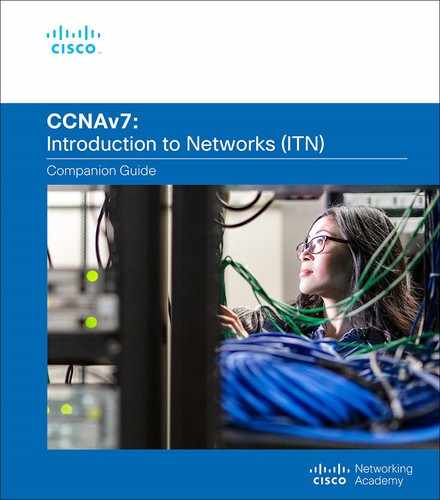Book Description
Introduction to Networks (CCNA v7)Companion Guide is designed as a portable desk reference to use anytime, anywhere to reinforce the material from the Introduction to Networks course and organize your time.
The book’s features help you focus on important concepts to succeed in this course:
Chapter Objectives – Review core concepts by answering the focus questions listed at the beginning of each chapter.
Key Terms – Refer to the lists of networking vocabulary introduced and highlighted in context in each chapter.
Glossary – Consult the comprehensive Glossary with more than 250 terms.
Summary of Activities and Labs – Maximize your study time with this complete list of all associated practice exercises at the end of each chapter.
Check Your Understanding – Evaluate your readiness with the end-of-chapter questions that match the style of questions you see in the online course quizzes. The answer key explains each answer.
How To – Look for this icon to study the steps you need to learn to perform certain tasks.
Interactive Activities – Reinforce your understanding of topics with dozens of exercises from the online course identified throughout the book with this icon.
Videos – Watch the videos embedded within the online course.
Packet Tracer Activities – Explore and visualize networking concepts using Packet Tracer. There are 40 exercises interspersed throughout the chapters and provided in the accompanying Labs & Study Guide book.
Part of the Cisco Networking Academy Series from Cisco Press, books in this series support and complement the Cisco Networking Academy curriculum.
Table of Contents
- Cover Page
- About This eBook
- Title Page
- Copyright Page
- About the Contributing Authors
- Contents at a Glance
- Reader Services
- Contents
- Command Syntax Conventions
- Introduction
- Figure Credits
- Chapter 1. Networking Today
- Objectives
- Key Terms
- Introduction (1.0)
- Networks Affect Our Lives (1.1)
- Network Components (1.2)
- Network Representations and Topologies (1.3)
- Common Types of Networks (1.4)
- Internet Connections (1.5)
- Reliable Networks (1.6)
- Network Trends (1.7)
- Network Security (1.8)
- The IT Professional (1.9)
- Summary (1.10)
- Practice
- Check Your Understanding Questions
- Chapter 2. Basic Switch and End Device Configuration
- Objectives
- Key Terms
- Introduction (2.0)
- Cisco IOS Access (2.1)
- IOS Navigation (2.2)
- The Command Structure (2.3)
- Basic Device Configuration (2.4)
- Save Configurations (2.5)
- Ports and Addresses (2.6)
- Configure IP Addressing (2.7)
- Verify Connectivity (2.8)
- Summary (2.9)
- Practice
- Check Your Understanding Questions
- Chapter 3. Protocols and Models
- Chapter 4. Physical Layer
- Chapter 5. Number Systems
- Chapter 6. Data Link Layer
- Chapter 7. Ethernet Switching
- Chapter 8. Network Layer
- Chapter 9. Address Resolution
- Chapter 10. Basic Router Configuration
- Chapter 11. IPv4 Addressing
- Objectives
- Key Terms
- Introduction (11.0)
- IPv4 Address Structure (11.1)
- IPv4 Unicast, Broadcast, and Multicast (11.2)
- Types of IPv4 Addresses (11.3)
- Network Segmentation (11.4)
- Subnet an IPv4 Network (11.5)
- Subnet a Slash 16 and a Slash 8 Prefix (11.6)
- Subnet to Meet Requirements (11.7)
- VLSM (11.8)
- Structured Design (11.9)
- Summary (11.10)
- Practice
- Check Your Understanding Questions
- Chapter 12. IPv6 Addressing
- Objectives
- Key Terms
- Introduction (12.0)
- IPv4 Issues (12.1)
- IPv6 Address Representation (12.2)
- IPv6 Address Types (12.3)
- GUA and LLA Static Configuration (12.4)
- Dynamic Addressing for IPv6 GUAs (12.5)
- Dynamic Addressing for IPv6 LLAs (12.6)
- IPv6 Multicast Addresses (12.7)
- Subnet an IPv6 Network (12.8)
- Summary (12.9)
- Practice
- Check Your Understanding Questions
- Chapter 13. ICMP
- Chapter 14. Transport Layer
- Chapter 15. Application Layer
- Chapter 16. Network Security Fundamentals
- Chapter 17. Build a Small Network
- Objectives
- Key Terms
- Introduction (17.0)
- Devices in a Small Network (17.1)
- Small Network Applications and Protocols (17.2)
- Scale to Larger Networks (17.3)
- Verify Connectivity (17.4)
- Host and IOS Commands (17.5)
- Troubleshooting Methodologies (17.6)
- Troubleshooting Scenarios (17.7)
- Summary (17.8)
- Practice
- Check Your Understanding Questions
- Appendix A. Answers to “Check Your Understanding” Questions
- Key Terms Glossary
- Index
- Code Snippets
